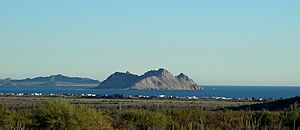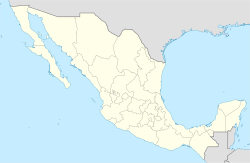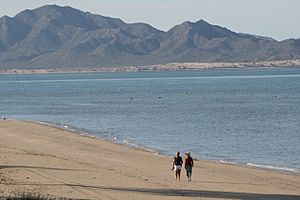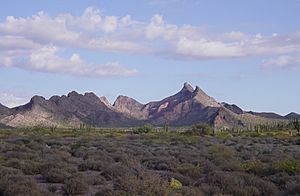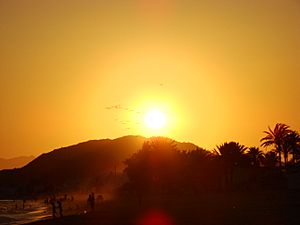Bahía Kino facts for kids
|
Native name:
Spanish: Bahía de Kino, Bahía Kino
|
|
|---|---|
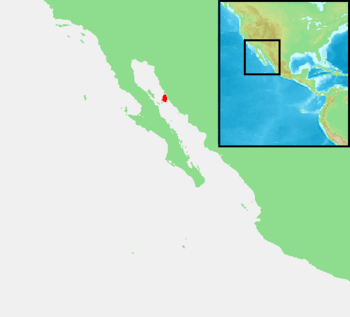
Location of Bahía de Kino Punta San Nicolás
|
|
|
Location in Mexico
|
|
| Geography | |
| Location | Gulf of California |
| Coordinates | 28°49′00″N 111°56′00″W / 28.81667°N 111.93333°W |
| Administration | |
|
Mexico
|
|
| State | Sonora |
| Demographics | |
| Population | 7,000 (2008) |
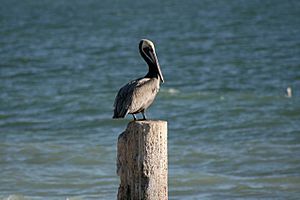
Bahía Kino is a town in Sonora, Mexico. It is located on the Gulf of California and is part of the Hermosillo Municipality. The town was named after Eusebio Kino. About 7,000 people live there. The name Bahía Kino also refers to the bay itself, which is found between Tiburón Island and Punta San Nicolás. You might hear it called Bahía de Kino, Bahía Kino, or Kino Bay. All these names mean the same place.
Contents
What is the History of Bahía Kino?
Who Lived in Bahía Kino First?
The first people to live in the Bahía de Kino area were the Comcaac, also known as the Seri. They were hunter-gatherers, meaning they hunted animals and gathered plants for food. They lived in small groups along the coast. Padre Eusebio Kino likely visited the bay in 1685. He named it Bahía San Juan Bautista. The Comcaac people were very good at living in the tough desert environment. This helped them stay independent from the Spaniards who came to the region.
How Did Fishing Start in Bahía Kino?
The first non-native settlers arrived in the early 1920s. They set up a small fishing camp. They mainly fished for a type of fish called Totoaba, which was very common around nearby Isla Alcatraz. In 1922, an American named Yates Holmes started a hunting and fishing camp called the Kino Bay Club. This club brought many visitors from the United States to Bahía de Kino.
By 1935, local fishers formed their first cooperative. This helped them work together. In the late 1930s, fishing for shark became very important. The sharks were used to make vitamin A supplements. By 1945, the town had grown to about 500 people, mostly involved in fishing.
How Did Bahía Kino Grow and Change?
In the mid-1940s, large boats began fishing for shrimp in the waters near Bahía de Kino. These boats usually came from Guaymas. In 1953, the road to Hermosillo was paved. This made it easier to sell fish and other products. It also made it simpler for tourists to visit. Land was set aside for the town to grow and for new tourist businesses. This helped create more jobs for the people of Kino.
In the 1960s, people started fishing for scallops in the bay. Fishers would dive from their boats to collect them. Later, around 1974, they began using air compressors to dive deeper and stay underwater longer. This helped them catch more scallops.
The 1970s saw a big increase in the town's population. Many new people moved to Bahía de Kino from other parts of Mexico. They came looking for steady work in the growing fishing industry. In 1975, the Mexican government stopped totoaba fishing. This was because too many fish had been caught, especially where they laid their eggs.
What About Recent Developments?
From the 1980s to the late 1990s, fishing in Bahía de Kino continued to grow. More fishers and boats were working in a larger area. Around 1990, catching crab became another important part of the fishing industry.
In the late 1990s, some shrimp farms started operating near Bahía de Kino. In 2006, a plan was approved to build a marina in Kino Bay. However, not much has happened with this plan yet. The boat ramps have been rebuilt several times after being damaged by hurricanes.
What is the Climate Like in Bahía Kino?
Bahía de Kino has a desert climate. This means it is usually very dry and hot.
| Climate data for Bahía de Kino, Sonora (1981–2010, extremes (1974-present) | |||||||||||||
|---|---|---|---|---|---|---|---|---|---|---|---|---|---|
| Month | Jan | Feb | Mar | Apr | May | Jun | Jul | Aug | Sep | Oct | Nov | Dec | Year |
| Record high °C (°F) | 29.0 (84.2) |
30.0 (86.0) |
33.0 (91.4) |
38.0 (100.4) |
40.0 (104.0) |
47.0 (116.6) |
42.0 (107.6) |
41.5 (106.7) |
42.0 (107.6) |
38.0 (100.4) |
35.0 (95.0) |
29.0 (84.2) |
47.0 (116.6) |
| Mean daily maximum °C (°F) | 19.5 (67.1) |
21.3 (70.3) |
22.7 (72.9) |
25.2 (77.4) |
27.3 (81.1) |
30.9 (87.6) |
32.6 (90.7) |
33.5 (92.3) |
33.0 (91.4) |
28.8 (83.8) |
23.7 (74.7) |
20.3 (68.5) |
26.6 (79.9) |
| Daily mean °C (°F) | 13.2 (55.8) |
14.4 (57.9) |
15.7 (60.3) |
18.2 (64.8) |
20.5 (68.9) |
24.7 (76.5) |
28.1 (82.6) |
28.7 (83.7) |
27.5 (81.5) |
22.2 (72.0) |
17.0 (62.6) |
13.8 (56.8) |
20.3 (68.5) |
| Mean daily minimum °C (°F) | 6.9 (44.4) |
7.5 (45.5) |
8.7 (47.7) |
11.2 (52.2) |
13.6 (56.5) |
18.5 (65.3) |
23.6 (74.5) |
23.9 (75.0) |
22.1 (71.8) |
15.7 (60.3) |
10.2 (50.4) |
7.2 (45.0) |
14.1 (57.4) |
| Record low °C (°F) | −1.0 (30.2) |
−4.0 (24.8) |
2.0 (35.6) |
3.0 (37.4) |
5.5 (41.9) |
9.0 (48.2) |
17.0 (62.6) |
16.0 (60.8) |
12.0 (53.6) |
7.0 (44.6) |
2.0 (35.6) |
0.0 (32.0) |
−4.0 (24.8) |
| Average precipitation mm (inches) | 12.5 (0.49) |
7.0 (0.28) |
3.1 (0.12) |
1.2 (0.05) |
0.4 (0.02) |
2.2 (0.09) |
15.3 (0.60) |
50.9 (2.00) |
23.0 (0.91) |
12.5 (0.49) |
5.5 (0.22) |
27.7 (1.09) |
161.3 (6.35) |
| Average precipitation days (≥ 0.1 mm) | 2.5 | 1.3 | 0.5 | 0.5 | 0.1 | 0.3 | 2.5 | 3.3 | 1.9 | 0.9 | 1.3 | 2.5 | 17.6 |
| Source: Servicio Meteorológico Nacional | |||||||||||||
What is Bahía Kino Like Today?
Bahía de Kino has between 6,000 and 8,000 people living there all the time. Many tourists from Mexico and other countries visit the area. Some foreign residents have even built homes in the town.
The town is managed as part of the Hermosillo area. It is located on land that used to belong to the Comcaac (Seri) people. They now live north of the town on their own land.
Even though fishing is very important here, there are no big ports or harbors. All the fishing happens right off the beach. There are two public boat ramps. One is southeast of town at Laguna La Cruz. The other is about 6 miles (10 km) northwest of town, called 'Playa Estela'. You can also anchor boats south of Isla Alcatraz. The large Laguna La Cruz offers a safe place to anchor boats.
People in Bahía de Kino often talk about Kino Viejo ('Old Kino') and Kino Nuevo ('New Kino'). Kino Viejo is the original village and where most of the shops are today. Kino Nuevo refers to the homes, motels, RV parks, and restaurants that stretch along the coast to the northwest.
See also
 In Spanish: Bahía de Kino para niños
In Spanish: Bahía de Kino para niños


